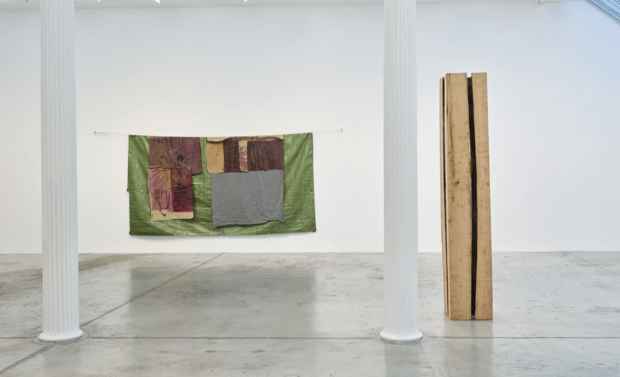“Junkyard of Dreams” Exhibition
Bortolami

This event has ended.
Bortolami Gallery presents its first exhibition of 2023 at 39 Walker Street, featuring five artists: Frieda Toranzo Jaeger, Duane Linklater, Virginia Overton, Kathleen Ryan, and Christopher Williams.
The artworks on view are contextualized within North American post- industrialization and its myriad socio-technical transformations, coalescing into a portrait of a world inherited without its major sites of local industry. These artworks function as both relics and futurist dreamscapes; not only a record of concerted changes in productivity, labor, and consumption throughout the continent prior the turn of the 21st century, but also a prescient vision of industry’s future. Major centers of production, from lumber to automotive fabrication, steeply declined in the post-war period affecting working class groups sharply yet unevenly, and opening up new areas for what stood as typical American work, while leaving behind a host of husked sites.
The title of the exhibition borrows from the concluding chapter of the late Mike Davis’ seminal book, City of Quartz. “Junkyard of Dreams” describes the history of Fontana, California and its journey from thriving agricultural community to steel town and the final erosion of its industrial economy after the closure of its plant. In tracing this particular area, Davis excavates the process of social dislocation and environmental decay brought forth by industry’s promises and retractions.
Kathleen Ryan’s sculptures revitalize the detritus of forgone Americana, from bowling balls and kitsch home ornamentation, to rusted car parts and tv satellites. The litter of outmoded ways of life is enlarged and transformed into snapshots of nature morte, capturing industrial waste as organic decomposition. A dislocated American-made red pickup truck hood is a shell- like structure, once webbed by Ryan’s bejeweled dew it oscillates as machinic and oceanic cast off.
Salvaged farm refuse forms the minimalist vocabulary of Virginia Overton’s sculpture. Culling her material from an agricultural landscape which merges manufacturing and nature, the sculptures speak to the inevitability of transfiguration embedded in the overlapping of these realms. The two totemic wood sculptures found in the exhibition are inverted black cherry and white oak logs from the artist’s family farm in Tennessee; precisely quartered and arranged centrifugally, they use modernism’s form to underscore farming’s reorganization of the organic to the builderly.
Christopher Williams’ photography engages the concise language of advertisement, revealing the conditions of the medium in post-industrial society. An exactingly staged black and white photograph of men’s leather shoes amplifies a web of invisible labor, from the artist’s framing and capturing of the complicated image, to the garment’s ubiquity among security guards and service staff. Three hand-painted painted aluminum signs by Williams signal a pre-digital mode of information distribution, referring to the possibility of technical goods within the site in which the pieces are exhibited, a description of the literal works and work within the gallery space.
Duane Linklater’s practice deploys the fabrication methods of his First Nations tribe against the backdrop of settler industrialism. Linklater foregrounds an interminable sense of making, a twinned history of deft construction inherited from his maternal ancestry—what could be understood as women’s craft work of the Moose Cree tribe—and the appropriation of indigenous labor for expansive projects of building. Two heroically proportioned abstract paintings’ materials hold this dual and overlapping history, where the coming and going of ecologically unsound industries are contentious of and highly dependent on Indigenous communities.
Vehicles populate Frieda Toranzo Jaeger’s painted iconography, their dashboards and modular formats recalling altars. The religious symbolism which undergirded the colonial expansionism of the 15th century is here married with the contemporaneous American drive for automation and space exploration. Futurity promises new relations not yet eked out and always in negotiation, so that Toranzo Jaegers’ scenes oblige a view of the world never totally absorbed in capitalism’s goals.
Media
Schedule
from January 13, 2023 to March 04, 2023